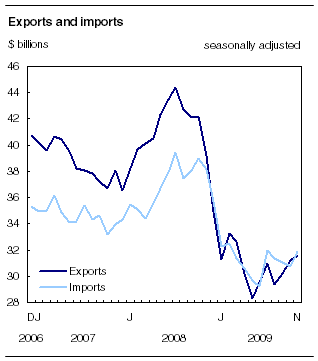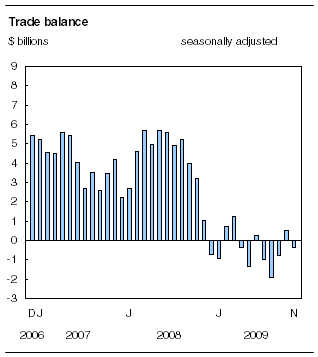Common menu bar links
Canadian international merchandise trade
Archived Content
Information identified as archived is provided for reference, research or recordkeeping purposes. It is not subject to the Government of Canada Web Standards and has not been altered or updated since it was archived. Please "contact us" to request a format other than those available.
Related subjects
Canada's merchandise exports increased 1.1% in November on the strength of energy products, while imports rose 3.9% due to widespread gains. As a result, Canada's trade balance with the world went from a surplus of $503 million in October to a deficit of $344 million in November.

Exports increased to $31.6 billion in November, marking the fifth increase in six months, as prices rose 1.1% and volumes remained unchanged. Energy products were the main factor behind the gain in November. Excluding energy products, exports fell 0.3%.
Export prices and volumes have each fallen by 16% since the value of exports peaked in July 2008.
Imports increased by $1.2 billion to $31.9 billion in November, almost offsetting the declines of the previous three months. The rise in imports represented the third monthly gain in 2009, as volumes increased 2.7% while prices rose 1.1%.
After peaking in July 2008, the value of imports fell by almost 20%, mostly the result of a 17% decline in volumes.
Most import sectors posted gains, with automotive products, machinery and equipment, and energy products accounting for the bulk of November's increase. The exception was industrial goods and materials.
Exports to the United States rose 2.0% while imports, which increased 3.8%, accounted for almost two-thirds of the gain in overall imports. As a result, Canada's trade surplus with the United States narrowed to $3.2 billion in November from $3.5 billion in October.
Note to readers
Merchandise trade is one component of Canada's international balance of payments, which also includes trade in services, investment income, current transfers as well as capital and financial flows.
International merchandise trade data by country are available on both a balance of payments and a customs basis for the United States, Japan and the United Kingdom. Trade data for all other individual countries are available on a customs basis only. Balance of payments data are derived from customs data by making adjustments for characteristics such as valuation, coverage, timing and residency. These adjustments are made to conform to the concepts and definitions of the Canadian System of National Accounts.
Constant dollars are calculated using the Laspeyres volume formula.
As of January 21, 2010, a new version of the Canadian International Merchandise Trade database will offer Harmonized System import and export data at the 6 digit level (HS6), at no cost. The data on the new version will be the same as released today. More detailed data for imports at the HS10 level and for exports at the HS8 level will be available as custom tabulations exclusively from International Trade Division.
Revisions
In general, merchandise trade data are revised on an ongoing basis for each month of the current year. Current year revisions are reflected in both the customs and balance of payments based data. Revisions to customs based data for the previous year are released on a quarterly basis. Revisions to balance of payments based data for the three previous years are released annually in June.
Factors influencing revisions include late receipt of import and export documentation, incorrect information on customs forms, replacement of estimates with actual figures, changes in classification of merchandise based on more current information, and changes to seasonal adjustment factors.
Revised data are available in the appropriate CANSIM tables.
Exports to countries other than the United States fell 1.2% while imports from these countries increased 4.0%. Consequently, Canada's trade deficit with countries other than the United States widened to $3.6 billion in November from $3.0 billion in October.

Exports grow on the strength of crude petroleum
Exports of energy products rose 6.2% to $7.4 billion as prices increased 5.8%. Crude petroleum exports, up 7.0%, rose for a third consecutive month and reached their highest level since October 2008. This gain was due to a 4.0% rise in volumes and a 2.8% increase in prices. Prices of crude petroleum exports have generally been on an upward trend since January 2009. Exports of other energy products and natural gas also posted gains in November.
After leading the growth in exports the previous two months, exports of industrial goods and materials fell 2.5% to $7.0 billion. The decline was mainly the result of a 2.1% reduction in volumes. Exports of precious metals declined 19.3% and were the main contributor to the decrease. Higher exports of organic chemicals moderated the decline in this sector.
Trucks lead the gain in imports
Imports of automotive products increased 9.4% to $5.3 billion, entirely the result of increased volumes. Since falling to $3.9 billion in January 2009, imports of automotive products have generally been trending upward. In November, imports of trucks and other motor vehicles grew 30.1%, and accounted for two-thirds of the gain in this sector. Higher imports of pickup trucks were the main factor behind this increase. Imports of passenger autos rose 7.2% and imports of motor vehicle parts increased 1.4%.
After three consecutive months of decline, imports of machinery and equipment increased 4.3% to $8.8 billion. This was mainly as a result of volumes rising 3.3%. Although the gains were widespread throughout the sector, imports of aircraft, up 22.2%, led the growth followed by office machines and equipment, up 8.7%.
Energy products imports rose 13.1% to $3.1 billion on the strength of crude petroleum, and coal and other related products. Imports of crude petroleum increased 10.1% as prices grew 16.3%. Volumes fell 5.4% as inventories of crude petroleum remained high. Imports of coal and other related products, namely natural gas, grew in November as a result of rising volumes.
Imports of industrial goods and materials declined 2.9% to $6.1 billion. Imports of precious metals, which had posted solid gains over the previous three months, fell 21.4% in November but remained 73.1% above the November 2008 value. Although the price of precious metals has risen 9.1% since November 2008, the gain was mainly due to a substantial 58.7% rise in volume. Imports of chemicals and plastics decreased 3.4%, mostly as a result of lower imports of pharmaceutical ingredients.
Available on CANSIM: tables 228-0001 to 228-0003, 228-0033, 228-0034, 228-0041 to 228-0043 and 228-0047 to 228-0057.
Definitions, data sources and methods: survey numbers, including related surveys, 2201, 2202 and 2203.
The November 2009 issue of Canadian International Merchandise Trade, Vol. 63, no. 11 (65-001-X, free), is now available from the Key resource module of our website under Publications.
Current account data (which incorporate merchandise trade statistics, service transactions, investment income and transfers) are available quarterly in Canada's Balance of International Payments (67-001-X, free).
For more information, contact Sharon Nevins (toll-free 1-800-294-5583; 613-951-9798). To enquire about the concepts, methods or data quality of this release, contact Mychèle Gagnon (613-951-0994), International Trade Division.
Table 1
| November 2008 | October 2009r | November 2009 | October to November 2009 | November 2008 to November 2009 | |
|---|---|---|---|---|---|
| Seasonally adjusted, $ current | |||||
| $ millions | % change | ||||
| Principal trading partners | |||||
| Exports | |||||
| United States | 28,966 | 22,836 | 23,283 | 2.0 | -19.6 |
| Japan | 1,129 | 791 | 743 | -6.1 | -34.2 |
| European Union1 | 2,962 | 2,864 | 2,823 | -1.4 | -4.7 |
| Other OECD countries2 | 2,088 | 1,621 | 1,408 | -13.1 | -32.6 |
| All other countries | 4,031 | 3,125 | 3,324 | 6.4 | -17.5 |
| Total | 39,177 | 31,237 | 31,582 | 1.1 | -19.4 |
| Imports | |||||
| United States | 24,189 | 19,313 | 20,047 | 3.8 | -17.1 |
| Japan | 1,096 | 757 | 776 | 2.5 | -29.2 |
| European Union1 | 4,053 | 3,418 | 3,412 | -0.2 | -15.8 |
| Other OECD countries2 | 2,397 | 1,960 | 2,283 | 16.5 | -4.8 |
| All other countries | 6,394 | 5,287 | 5,408 | 2.3 | -15.4 |
| Total | 38,129 | 30,734 | 31,926 | 3.9 | -16.3 |
| Balance | |||||
| United States | 4,777 | 3,523 | 3,236 | ... | ... |
| Japan | 33 | 34 | -33 | ... | ... |
| European Union1 | -1,091 | -554 | -589 | ... | ... |
| Other OECD countries2 | -309 | -339 | -875 | ... | ... |
| All other countries | -2,363 | -2,162 | -2,084 | ... | ... |
| Total | 1,048 | 503 | -344 | ... | ... |
| Principal commodity groupings | |||||
| Exports | |||||
| Agricultural and fishing products | 3,623 | 2,848 | 2,947 | 3.5 | -18.7 |
| Energy products | 8,511 | 6,921 | 7,350 | 6.2 | -13.6 |
| Forestry products | 2,125 | 1,573 | 1,613 | 2.5 | -24.1 |
| Industrial goods and materials | 8,980 | 7,168 | 6,988 | -2.5 | -22.2 |
| Machinery and equipment | 8,327 | 6,167 | 6,151 | -0.3 | -26.1 |
| Automotive products | 4,895 | 4,179 | 4,124 | -1.3 | -15.8 |
| Other consumer goods | 1,466 | 1,445 | 1,505 | 4.2 | 2.7 |
| Special transactions trade3 | 714 | 516 | 497 | -3.7 | -30.4 |
| Other balance of payments adjustments | 536 | 421 | 407 | -3.3 | -24.1 |
| Imports | |||||
| Agricultural and fishing products | 2,560 | 2,378 | 2,429 | 2.1 | -5.1 |
| Energy products | 3,974 | 2,784 | 3,148 | 13.1 | -20.8 |
| Forestry products | 244 | 192 | 195 | 1.6 | -20.1 |
| Industrial goods and materials | 7,837 | 6,320 | 6,137 | -2.9 | -21.7 |
| Machinery and equipment | 11,259 | 8,451 | 8,816 | 4.3 | -21.7 |
| Automotive products | 5,793 | 4,841 | 5,296 | 9.4 | -8.6 |
| Other consumer goods | 5,243 | 4,694 | 4,696 | 0.0 | -10.4 |
| Special transactions trade3 | 467 | 399 | 514 | 28.8 | 10.1 |
| Other balance of payments adjustments | 752 | 675 | 694 | 2.8 | -7.7 |

